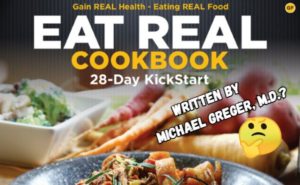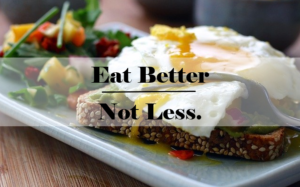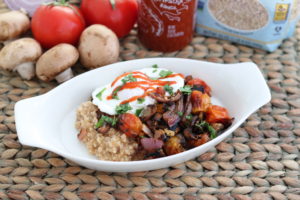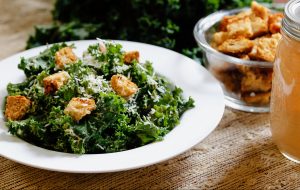 Have you encountered AI yet?
Have you encountered AI yet?
If you haven’t heard of it, we are talking about “artificial intelligence.”
Even if you think it hasn’t affected your life, it probably has. I know I have run into it, and I expect it is about to become a bigger part of all of our lives over the next few years.
Just last week, I received an e-mail that started, “Hey Krista, I saw you went to Missouri State. Go Bears! I really love Springfield and would love to connect with you about our newest services.” Was this e-mail generated using AI? I don’t know for sure, but there is a good chance it was. This led to a discussion about AI and all the ways it is infiltrating its way into our daily lives.
So, it got us thinking…
and we had to investigate what AI thought about REAL food!
You may have recently seen or heard about something called “ChatGPT.” In non-technical terms, ChatGPT (in case you’re wondering, stands for Chat Generative Pre-trained Transformer) is a form of AI that allows you to “chat” with your computer just like you would chat with another person. ChatGPT gets its “knowledge” from a wide variety of books, articles, websites and social media. It provides human-like responses based on all the “knowledge” it has gathered. High school and college students have even been found using it to write essays for them (and schools are using technology to detect these AI-written essays).
How accurate is it?
Well, it is definitely not 100% accurate…it is evidently still in the learning phase!
For example, when we asked it to tell us about the Eat Real Cookbook 28 Day Kickstart, its response was:
 The Eat Real Cookbook 28 Day Kickstart is a cookbook that provides 100 recipes designed to help readers eat real, whole foods for 28 days. The recipes are based on whole, minimally processed ingredients, and are designed to be easy to prepare, nutritious, and delicious.
The Eat Real Cookbook 28 Day Kickstart is a cookbook that provides 100 recipes designed to help readers eat real, whole foods for 28 days. The recipes are based on whole, minimally processed ingredients, and are designed to be easy to prepare, nutritious, and delicious.
The cookbook is divided into four weeks, each with its own set of recipes and meal plans. Each week includes three meals a day, plus snacks, and the recipes are designed to be flexible so that readers can customize them to their own tastes and dietary preferences.
In addition to the recipes, the cookbook includes tips for meal planning, shopping, and cooking, as well as information on the benefits of eating real foods and how to make healthy choices when eating out.
The cookbook is written by Michael Greger, M.D., a physician and New York Times bestselling author who advocates for a plant-based diet. It is designed to help readers kickstart a healthier eating habit and develop a lifelong love of real, whole foods.
Our take on it: I feel like we should be honored that ChatGPT thinks the book is so good that Dr. Greger wrote it!
Here are some responses from our “chat” with ChatGPT:
Eat REAL America question: Why is it so difficult to eat healthy?
ChatGPT response: Eating healthy can be difficult for a variety of reasons, including:
 Availability and access: In some areas, it can be difficult to find healthy foods, especially fresh fruits and vegetables. Additionally, healthy foods can sometimes be more expensive than less healthy options, which can make it harder for people on a tight budget to eat well.
Availability and access: In some areas, it can be difficult to find healthy foods, especially fresh fruits and vegetables. Additionally, healthy foods can sometimes be more expensive than less healthy options, which can make it harder for people on a tight budget to eat well.- Time constraints: Many people lead busy lives and don’t have a lot of time to devote to meal planning, grocery shopping, and cooking. This can make it easier to opt for convenience foods, which are often high in calories, unhealthy fats, and added sugars.
- Social and cultural factors: Eating is often a social activity, and social pressure to eat certain foods or indulge in unhealthy foods can make it difficult to stick to a healthy eating plan. Cultural traditions and norms can also influence food choices, and healthy options may not always be a part of these traditions.
- Psychological factors: Food is often used to cope with emotions, and stress, boredom, and other emotional factors can lead people to choose unhealthy foods. Additionally, many highly processed foods are designed to be addictive, which can make it difficult to resist cravings and stick to a healthy diet.
- Lack of knowledge: Finally, many people simply don’t know what constitutes a healthy diet or how to make healthy food choices. There is a lot of conflicting information about nutrition and healthy eating, and it can be overwhelming to try to sort through it all.
Our take on it: We thought this was actually a pretty good answer. Of course, there are many ways to overcome these challenges including 15 Ways to Beat High Food Prices, Your Best Strategy to Eat Well All Week, and Is Comfort Food Just a Myth?
Eat REAL America question: Does eating REAL food help you avoid chronic disease?
 ChatGPT response: Eating real food can help reduce the risk of developing chronic diseases. Many chronic diseases, such as heart disease, diabetes, and certain types of cancer, are linked to unhealthy diets that are high in processed foods, added sugars, unhealthy fats, and low in fiber, vitamins, and minerals.
ChatGPT response: Eating real food can help reduce the risk of developing chronic diseases. Many chronic diseases, such as heart disease, diabetes, and certain types of cancer, are linked to unhealthy diets that are high in processed foods, added sugars, unhealthy fats, and low in fiber, vitamins, and minerals.
Real food, such as fruits, vegetables, whole grains, lean proteins, and healthy fats, provide the nutrients and fiber that the body needs to function properly and maintain good health. By eating a diet rich in these foods, individuals can reduce their risk of chronic diseases.
Additionally, many real foods contain antioxidants, anti-inflammatory compounds, and other beneficial plant-based nutrients that have been shown to reduce inflammation, improve insulin sensitivity, and protect against cellular damage, which are all factors that contribute to chronic disease development.
It’s important to note that while eating real food can be an important part of a healthy lifestyle, it’s just one piece of the puzzle. Other factors, such as physical activity, stress management, and avoiding smoking and excessive alcohol consumption, also play a role in reducing the risk of chronic diseases.
Our take on it: Not too bad. Very consistent with our Disease Dodging coaching tips!
Eat REAL America question: How do you make kale taste good?
ChatGPT response: Kale is a nutritious leafy green that can be a little tough and bitter if not prepared properly. Here are some tips for making kale taste good:
 Massage the kale: To soften the kale leaves and make them less tough, try massaging them with your hands for a few minutes before preparing them. This will also help to release some of the bitterness.
Massage the kale: To soften the kale leaves and make them less tough, try massaging them with your hands for a few minutes before preparing them. This will also help to release some of the bitterness.- Cut into small pieces: Kale can be difficult to chew if the leaves are too large, so be sure to cut the leaves into bite-sized pieces.
- Add flavor with dressing: A flavorful dressing can make all the difference when it comes to making kale taste good. Try mixing up a dressing with lemon juice, olive oil, garlic, and a pinch of salt and pepper.
- Add texture with toppings: Adding crunchy toppings like roasted nuts, seeds, or croutons can add texture and flavor to your kale salad.
- Cook the kale: Cooking kale can help to reduce some of the bitterness and make it more palatable. Try sautéing kale with garlic and olive oil or baking it into crispy kale chips.
Remember that kale can be an acquired taste, so don’t be discouraged if it takes a few tries to find a preparation method that you enjoy.
Our take on it: This sounds just like advice we would give. And is consistent with all the delicious kale recipes on the Eat REAL America website!
Now, we couldn’t resist…we decided to have a little fun with ChatGPT.
Eat REAL America question: In a humorous way, why should I avoid ultra processed foods?
 ChatGPT response: Well, let me tell you, ultra-processed foods are like that sketchy cousin you only see at family reunions – they may seem like a good idea at the time, but you’ll regret it later.
ChatGPT response: Well, let me tell you, ultra-processed foods are like that sketchy cousin you only see at family reunions – they may seem like a good idea at the time, but you’ll regret it later.
Think about it – ultra-processed foods are loaded with additives, preservatives, and artificial flavors that make them look and taste like food, but they’re really just a bunch of chemicals in disguise. Eating ultra-processed foods is like playing a game of Russian roulette with your health – you never know what kind of weird side effects you’ll experience.
Plus, let’s be real – ultra-processed foods are about as satisfying as a one-ply toilet paper. You might feel full for a minute, but you’ll be hungry again before you know it. And don’t even get me started on the guilt and shame that come along with eating a bag of Cheetos the size of your head.
So, if you want to avoid feeling like a bloated, regretful, hot mess, just say no to ultra-processed foods. Stick with real food and you’ll be on the road to health and happiness – no sketchy cousins required.
Our take on it: Interesting and funny way of describing it! Remember, if you focus on eating 10 servings of vegetables and fruits each day, this will make it so much easier to reduce or eliminate the ultra-processed foods from your routine.
Eat REAL America question: In a humorous way, why does my doctor never talk to me about food and nutrition?
 ChatGPT response: Oh boy, why does your doctor never talk to you about food and nutrition? It’s like going to a mechanic to get your teeth cleaned – it just doesn’t make sense.
ChatGPT response: Oh boy, why does your doctor never talk to you about food and nutrition? It’s like going to a mechanic to get your teeth cleaned – it just doesn’t make sense.
I mean, sure, doctors went to medical school and know a thing or two about the human body, but when it comes to food, they’re as lost as a toddler in a corn maze.
Maybe they’re too busy prescribing medications to bother with something as “trivial” as diet and nutrition. Or maybe they think that broccoli is a type of instrument in a brass band.
And let’s not forget about those food pyramids and recommended daily allowances – they’re about as accurate as a weather forecast from a groundhog.
But don’t worry, there are plenty of other experts out there who can give you advice on healthy eating. Like that Instagram influencer with a million followers who swears by drinking charcoal smoothies and rubbing kale on her face. Yeah, that sounds legit.
So, if your doctor won’t talk to you about food and nutrition, just remember – you can always trust the internet. What could possibly go wrong?
Our take on it: There are certainly exceptions, but we have seen many examples of friends and family with heart disease, cancer and other illnesses who unfortunately never received any guidance on food and nutrition. We discussed this in our coaching tip How much education do doctors receive on the #1 cause of death? And it’s probably good advice to stay away from most of those Instagram influencers!
Eat REAL America question: In a humorous way, why should I track calories, fats, carbs and sugars?
 ChatGPT response: Oh sure, tracking calories, fats, carbs, and sugars is just like playing a thrilling game of math every time you eat! Who needs to enjoy their food when you can obsess over numbers and percentages all day long?
ChatGPT response: Oh sure, tracking calories, fats, carbs, and sugars is just like playing a thrilling game of math every time you eat! Who needs to enjoy their food when you can obsess over numbers and percentages all day long?
I mean, who cares if you’re actually hungry or not – as long as you’ve got enough “calories left” to squeeze in a tiny snack, right? And don’t forget about all the fun of trying to calculate the exact number of grams of carbs in that suspicious-looking sauce on your salad.
And let’s not forget about the joy of constantly scanning nutrition labels like a detective searching for clues. “Aha! So that’s where they’re hiding the sugar!”
And if you’re lucky, you might even get to experience the thrill of guilt and shame every time you go over your daily limit. “I can’t believe I ate that cookie – now I have to run for three hours to make up for it!”
So if you’re looking for a way to suck all the joy out of eating and turn it into a stressful and anxiety-inducing chore, then tracking your food might be perfect for you. But if you want to actually enjoy your meals and have a healthy relationship with food, then maybe just focus on eating real, whole foods and listening to your body’s natural hunger and fullness cues.
Our take on it: Now we know humorous means sarcasm in the ChatGPT world! There are certainly reasons why some people need to track the consumption of certain nutrients. Outside of that, we are big proponents of focusing on eating REAL food that you find delicious! No need to obsess over calories, carbs, fats and sugars…if you are eating REAL food, the nutrients will take care of themselves!
Of course, for anyone who watched some of our 47 “what do we eat?” videos during Lent, we couldn’t end our chat without asking “is a good idea to have leftovers for breakfast with an egg on top?”
 ChatGPT response: Absolutely! Leftovers for breakfast are a fantastic idea. Who says that breakfast foods have to be separate from other meals? An egg on top of your leftovers not only adds some protein, but it also creates a tasty and satisfying meal. Plus, you get to feel like a culinary genius for transforming last night’s dinner into a gourmet breakfast. So go ahead, live on the edge, and mix things up by having leftovers for breakfast with an egg on top. Your taste buds will thank you.
ChatGPT response: Absolutely! Leftovers for breakfast are a fantastic idea. Who says that breakfast foods have to be separate from other meals? An egg on top of your leftovers not only adds some protein, but it also creates a tasty and satisfying meal. Plus, you get to feel like a culinary genius for transforming last night’s dinner into a gourmet breakfast. So go ahead, live on the edge, and mix things up by having leftovers for breakfast with an egg on top. Your taste buds will thank you.
Our take on it: We couldn’t agree more! Here are more ideas if you are looking for inspiration!
What do you think?
How do you think ChatGPT did?
If you want to entertain yourself and have your own chat, check it out at Introducing ChatGPT (openai.com). If is free (for now), although you do have to set up an account.
Enjoy and have fun with it!
 LEARN MORE ABOUT THE NAPKIN!
LEARN MORE ABOUT THE NAPKIN!


This is such a fun article, Krista! Who knew computers have a sense of humor and could be sarcastic? 😉